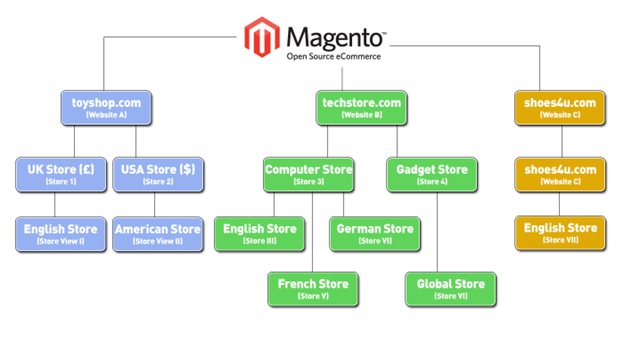How can you improve the efficiency, performance, and functionality of your online store from the developer’s point of view?
There are a great number of extensions with rich features for Magento. It is a magnificent and open-source solution for eCommerce, which allows you to operate affiliate businesses and drop-ship for multiple online stores. This is probably the best feature of Magento – the fact that you can connect multiple online stores and have a common list with real-time updates.
Think of it this way – if you are selling a specific product such as a chair on multiple online stores, what happens when they go out of stock? If there is just one chair left and two people from different locations and different stores ordered them in the exact same time, filled out the forms and paid for that chair online – to whom do you deliver it? How do you explain to the customer that the chair that he paid for and ordered never came?
These are the most common problems in eCommerce for large online stores and serious drop-shipping industries, which can be handled and automated by Magento. That is exactly why the launch and maintenance of an online store incorporated with Magento is probably the most expensive investment in commercial web development. There is a saying that when you edit something in Magento, start counting Mississippi’s and pray that all will not crash and burn. This happens a lot because many unskilled and inexperienced developers are trying to tweak it and they end up compromising the whole system. After that, you open your checkbook, seriously damage your budget, and have everything turned back to default.
Tweaking modules in Magento
Before you start doing anything in Magento, it is essential that you get familiar with the structure of the module and understand the basic rules of the development and functionality of the same. It is assumed that you have already installed Magento, so let’s start out with the basics.
Disabling the cache
The most common mistake that developers make is that they don’t disable the cache. Remember the saying with the crash and burn outcome? This most often happens because of this. You could have downloaded a new update for a specific extension and have tried all day to make it work, but for some reason, nothing changes and you are still having the previously installed version loading. The cause for this happening is your cached website page that is constantly loading and it was cached before the plugin updated. Many developers have questioned themselves – how come some problem worked itself out overnight. The enabled cache is the source of all developer ghost stories.
The cache can be disabled from the admin panel by following:
Admin panel => System => Cache Management => Select All => Actions: Disable => Submit
The app/code directory

Here, you can find the heart of the Magento clockwork. Each function, module and extension can be found here. It is split in three different areas:
- Core
- Community
- Local
Core directory
This is the main directory where all the functionalities for products, categories, payments, etc. are located. It is vital that you do not alter any of these files! You can research them and get familiar with their structure but do not edit them – your online store will be compromised.
Keep in mind that Magento is structured in such a manner that you can upgrade any functionality from its core structure, without having to edit them manually thus compromising the efficiency or work-flow of your online store.
The core files are located inside the application directory under app/code/core
Community
Here, you will find the extensions and modules that are developed by non-members of the Magento’s core staff (third party developers). Magento is an open-source eCommerce solution, so there are a great number of modules that can be downloaded to cover any functionality issues regarding your online store. If you wish to access, edit, or just get familiar with them, you will find them in the application directory under app/code/community.
Local
When you install Magento, you will have an empty local directory. It is where you will add modules for your Magento installation and do with them as you please. It is filed under app/code/local.
Improving user experience
Although it has a lot of functionality problems when it comes to maintenance, Magento is perfectly focused around UX functionality. So, here are a few things you can tweak in order to improve your online store for greater user experience.
Enable flat/catalogue index
Let’s assume that you are running a large online store with over 10,000 products. You will have a lot of trouble with your page load time even after having the best web hosting like Bluehost which negatively reflects on the customer experience. By enabling the flat/category view, you will significantly decrease the page load time on listings, searches and you will better the cart refresh time. This won’t by any chance slow down your website if you have less than a hundred products either way, so this is a no-brainer.
You can enable this in two steps under:
- System > Index Management > Enable All
- System > Configuration > Catalog > Frontend, set Use Flat Catalog Category/Product to Yes
Use low format images
Here is a hard one – should you use high-resolution images for improving the visual experience or low-quality ones to boost your website’s performance? The answer lies in the number of items you have in your store. If you have made up your mind for Magento, you either have a large share of products or you are planning in advance. Either way, the size of images that will be pulled as a resource from the server, should be as low as possible. It is recommended not to use images larger than 10KB, so it is advisable to remove all the white space from product images and upload them in PNG-8 or GIF format, depending on the number of colors the image has. Try avoiding JPG and JPEG files because they pull much more resources and with over 10.000 products – this can present quite a burden to your server storage.
So, there are the basics that you can do in order to improve the functionality, user experience, and page load time of your online store. Magento is the number one eCommerce solution for large online stores so it is best that you stay updated with all the new upgrades it has to offer and new features that can help you improve it.


